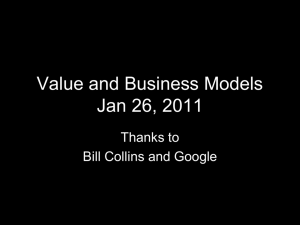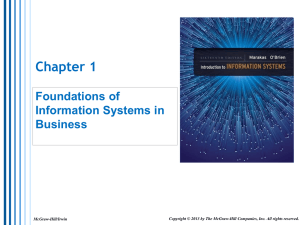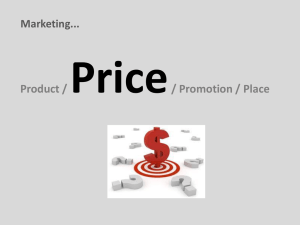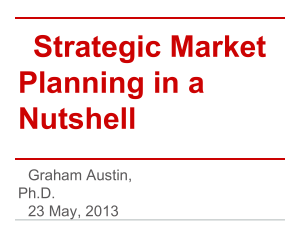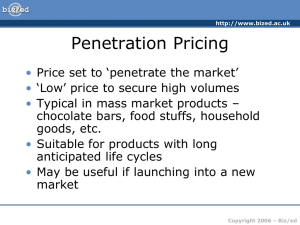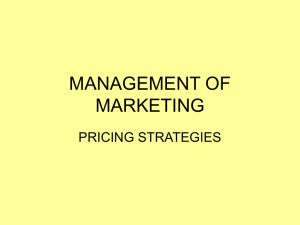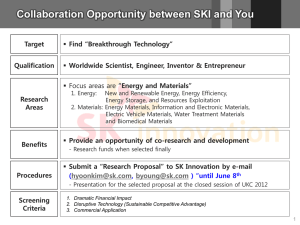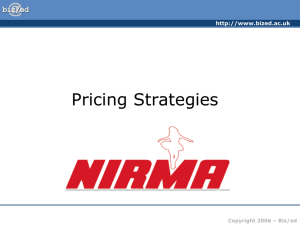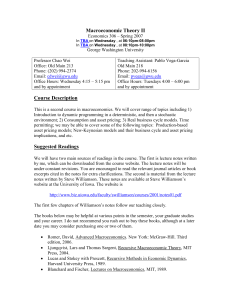Business Models Jan 22, 2009
advertisement
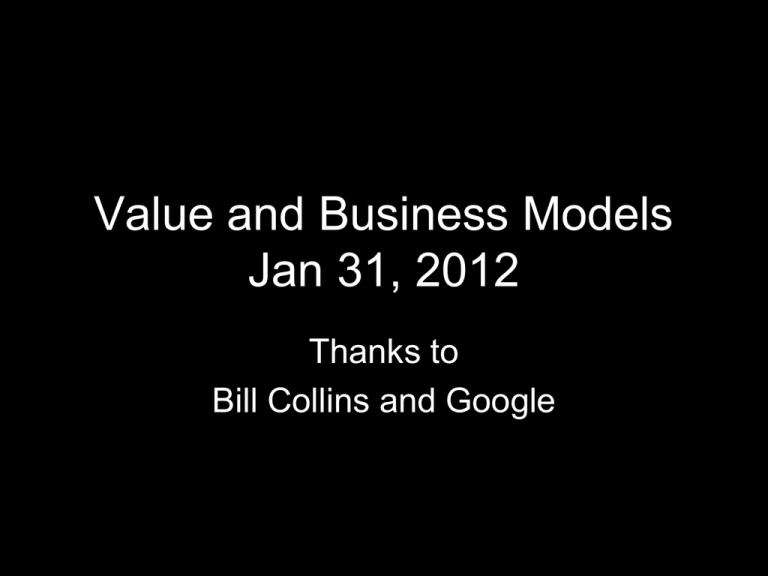
Value and Business Models Jan 31, 2012 Thanks to Bill Collins and Google Agenda • HW Presentations • Thoughts on the class so far – – – – – Team assessment Subjects to be covered HW marking Midterm Pivoting Lecture • Value Chain • Business Models • Exercise This week’s HW • Present results of your interviews and other research to date – >5 more interviews – What did you learn from each interview? From your secondary research (library, internet, etc.) – Show schedule of new interviews – Do your hypotheses need modification? – What is your plan to “fill in the gaps” – Characterize the industry your company would play in using Porter’s forces Midterm Tuesday, February 7 Submit presentation 5 pages (pdf) and 10 minute presentation (pdf of PPT) Continue Market interviews!! You should have made significant progress by next week! Don’t just rehash HW Contents 1. Updated Market Analysis. (40%) Show references 1. 2. Who is your customer? How big is he? How fast is he growing? What intense pain is this customer experiencing? Be as precise as possible in identifying customer. How big is the market segment? How fast is it growing? Be as precise as possible 2. Business model (20%) How will you make money? 3. What was the biggest surprise(s) you encountered in your research so far (10%) 4. Key issues to be resolved for the Final (20%) e.g., untested hypotheses. List as many major uncertainties as you can and some thoughts on how you will address them. 5. Team assessment summary (10%) Team Assessment (a suggested methodology) • Each person rates each other member of the team. Notes their strengths and weaknesses. Example of one persons results on next page) • Share and discuss • What issues need redressing? • What is your plan for redressing? • Overall takeaway Share takeaway of results for midterm. No names need be mentioned- just the process Example HW for two weeks Feb 14 • What is the value you provide your customers? 20% • How will you capture that value (Business Model)? Name at least 2. 40% • How will you price your product (s)? Why this way? 20% • How will your value capture be sustainable for 5 years? 20% Subjects to be covered • Marketing Research continues • Financial – Funding Sources – Modeling and Projections • Legal – Company initiation – Human Resources, Corporate, Pitfalls • • • • • • Leadership and initiation teams Core Competency and outsourcing Sales Ethics and Social responsibility How to write a business plan The nature of a start-up Value Chain • The Value Chain is the set of activities that a company engages in to produce a product. • At each activity the “nascent” product gains value • Some activities produce more value than others Value Chain • You have bought a new refrigerator – Describe your perception of value for all the people who “touched” it Value Chain • Let’s take one of the E 102 projects. Imagine you are the end customer. What is the value chain for the product you are using Value Chain • Key questions for you to address – What will the value chain be for your product? – What is the value contributed by each stage of the chain? – Where would you like to play? (Where will you capture the most value?) Business Models • Business Model as defined here is your structure for receiving compensation. • Your choice of business model (s) are a critical consideration for your company. • It is also a critical point of review by prospective financiers • Most companies do not exploit all the possibilities they have to monetize their product Business Models • List Business Models • • • • • • • Auction Bricks and clicks Cutting out the middleman model Direct sales model Distribution business models Franchise Freemium business model Business Models (continued) • • • • • Advertising through eyeballs Selling customer information Razor and Blades Subscription Servitization Business Models (continued) • • • • • • • Sell project Trading Insurance Publisher Broker Reseller Value added reseller Successful business Models have 1. Foothold: identify niche customer, early adopter Valuable Feedback Cheap marketing 2. Differentiation Amazon.com added – user reviews – recommendations, – wish lists – speedy shipping 3. Pricing • Pricing: Salesforce.com monthly service fee instead of large upfront fee Biz Models – Financial Questions 1. How will you charge for your solution? 2. What would make your customers excited about your price structure now? Over time? 3. How will you generate recurring sales from your customers (printers versus ink, hardware vs ongoing service)? Biz Models – Financial Questions 4. How will you deliver continuously increasing value over time? 5. How can you extend your model to enable continuous cash flow, profits and growth? 6. Is there more than one way to monetize your product? Biz Models – Financial Q’s 7. What gross margin can you generate? Primary indicator of value Needs to support your overhead Needs to allow room for partners/customers to make money. 8. How do you generate positive cash flow? Payment terms with suppliers and customers – bias these in your favor Working capital needs - minimize Understand who is paying the cost of money Biz Models – Financial Q’s 9. What are your sales/employee? 10. What is your “cost of growth” (scalability) 11. How defensible are your margins? consider Porter’s forces 12. How do all these affect the value of your enterprise? Apple • Revenue/employee = 200B/46K employees = 4M$/employee Set A Value Roadmap • You must plan to increase your value each year • Cost-performance improvement curve is inexorable • Stems from human expectations model – continuously expect more for less. Each industry has it’s norms. – Productivity improvements enable price reductions – Additional features enable stable or higher prices Cost versus performance Expectation Slower = margin loss Faster = margin gain Industry Case • Whether your model is selling “cell phones” or “minutes” you need a roadmap. – Cell phones: Started out expensive, got cheap, then were given away to get the minutes, now need to be combined with cameras and PDA’s to have value…… – Minutes: Started out expensive per unit, got cheaper, went to lump sum, then needed lots of additions just to keep the lump sum, eventually are basically free…. Pricing Fundamentals • Always price to value • Approaches: – Price to payback • Rule of thumb – 6 months to 1 year – Price to displace existing solutions on cost basis • Rule of thumb – 30% net savings or more – Price to displace existing solutions on performance basis • Rule of thumb – hard to get customers to pay more – Price to protect against indirect competition • Rule of thumb – highest price that allows end solution to stay attractive versus alternative approaches Value Factors • • • • • Price Performance Quality Lead-time **RISK/PRESTIGE PERCEPTION** Lead Customer Pricing • Lead customers are critical for validating value proposition and ROI, price – Sets a future “success pattern” – Lowers risk/increases prestige of solution – Eventually you want to become a “safe bet.” • Lead customers must pay for solution – Not credible otherwise – Can receive a favorable deal, but not too favorable The Pricing Acid Test Does your pricing excite both your customers and investors at the same time? Summary • Your business model must be: – Acceptable to your customers – Able to provide recurring sales. – Able to deliver more for less while generating profitable growth. • Your pricing must: – Have a clear reconciliation to value – Get early validation from lead customers. – Create excitement for both your customers and investors. Breakout What is your business model? HW for Next Week • What is the value you provide your customers? • How will you capture that value (Business Model)? Name at least 2. • How will you price your product(s)? • How will your value capture be sustainable for 5 years?
